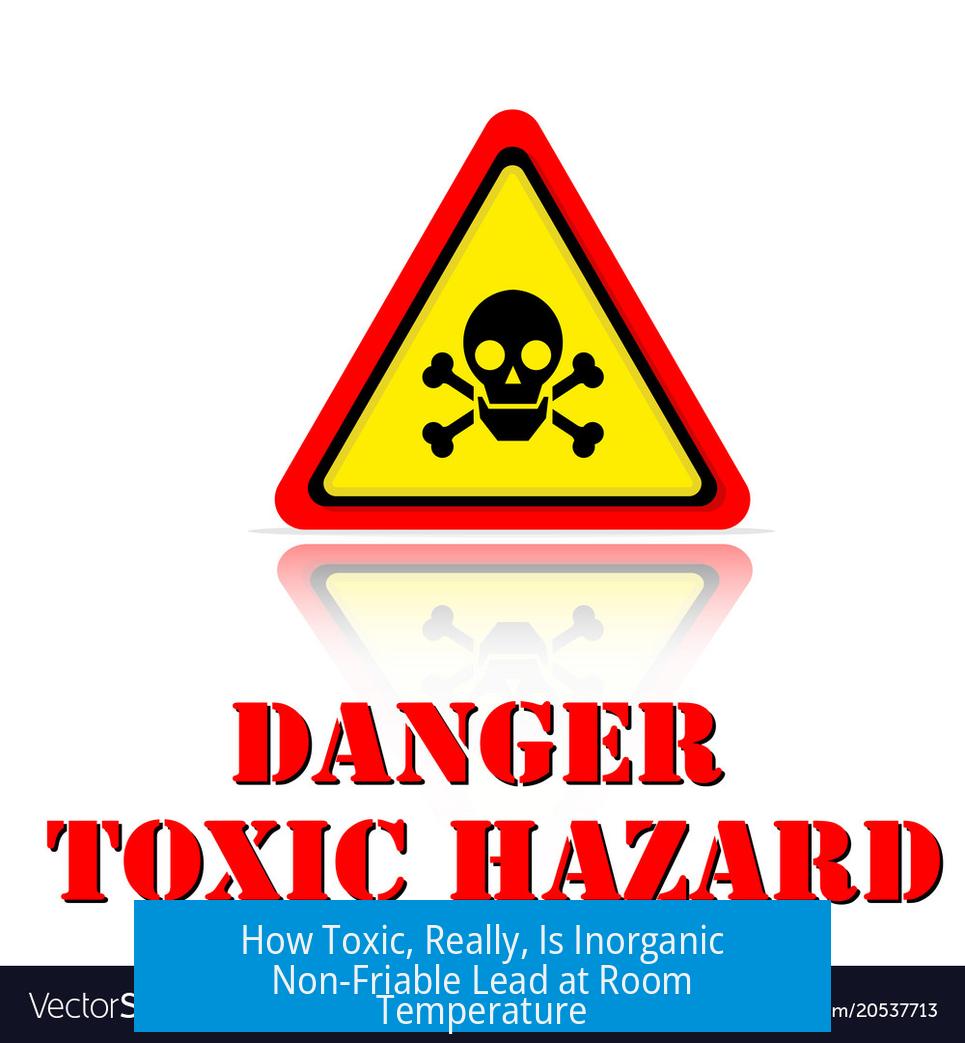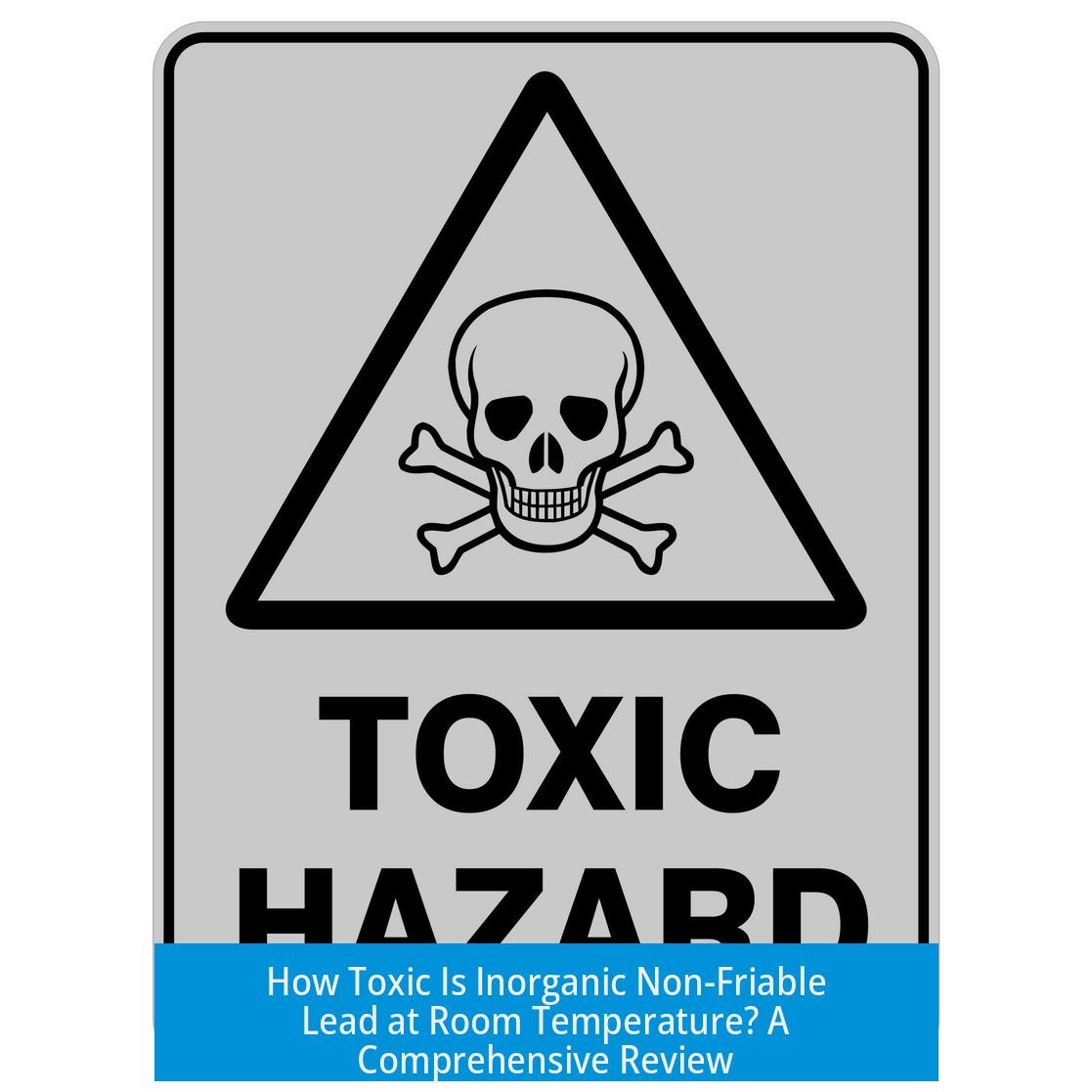How Toxic, Really, Is Inorganic Non-Friable Lead at Room Temperature?

Inorganic non-friable lead at room temperature is considerably less toxic than many of its chemical forms due to its low bioavailability. Direct skin contact with metallic lead presents minimal acute toxicity risk, as the metal is poorly absorbed by the body in this form. The primary danger arises from ingestion or inhalation of lead particles or lead salts, not from handling solid lead itself. Proper hygiene practices such as handwashing after contact substantially reduce any health risks.
The Nature of Inorganic Non-Friable Lead
“Inorganic non-friable lead” refers to elemental metallic lead that is solid and not prone to breaking down into dust or particles under normal conditions. At room temperature, this solid metal material does not readily release lead ions or particles, limiting its ability to enter the body.
- Non-friable: Not easily crumbled or pulverized into dust.
- Inorganic lead: Metallic lead as opposed to organic or salt forms.
- Room temperature stability: Solid lead remains stable, minimizing lead particle release.
Toxicity Depends on Bioavailability
Lead’s toxicity strongly correlates with its bioavailability, or how effectively it can enter and affect biological systems. Metallic lead in solid form has poor bioavailability. This means the body cannot easily absorb or utilize metallic lead, resulting in relatively low toxicity. In contrast, lead salts and organolead compounds dissolve more readily and penetrate biological barriers more effectively, increasing their toxicity.
Examples:
- Metallic lead: Low absorption through skin or gastrointestinal tract.
- Lead salts (e.g., lead acetate): Higher absorption via ingestion or inhalation.
- Organolead compounds: Easily cross membranes, highly toxic.
Routes of Exposure and Their Impact
The method by which the body contacts lead significantly influences toxicity levels.
- Skin contact: Handling metallic lead typically causes minimal absorption. The skin acts as a strong barrier.
- Ingestion: Swallowing lead particles or residues, such as from contaminated hands, may increase toxicity risk.
- Inhalation: Breathing in lead dust or fumes, particularly from lead salts or molten lead vapors, is highly hazardous.
Direct skin contact with non-friable metallic lead at room temperature usually does not generate lead dust or fumes. Thus, inhalation exposure risk from handling is negligible under normal conditions.
Practical Handling and Hygiene Measures
Many sources agree that brief contact with metallic lead objects, such as lead bullets, weights, or sinkers, involves very low acute toxicity if hygiene is maintained. Simple handwashing after handling prevents inadvertent ingestion of lead particles transferred from the metal to the mouth.
- Wash hands thoroughly after handling lead objects.
- Avoid eating or touching the face before cleaning hands.
- Use gloves where repetitive or prolonged handling occurs.
Such measures minimize the small risk posed by trace metal transfer and provide effective protection.
Chronic Lead Exposure and Neurological Risks
Long-term lead exposure, even at low levels, may affect brain chemistry and cognitive function. Lead accumulates slowly in biological tissues, and chronic ingestion or inhalation presents major health concerns.
| Blood Lead Level (Pb) | Health Implication |
|---|---|
| ≥10 μg/dL | Cause for medical concern |
Although acute toxicity from handling non-friable lead is low, repeated or prolonged exposure leading to measurable blood lead levels can impair neurological function. Symptoms may include cognitive decline or behavioral changes.
Historical and Occupational Context
Historical occupational exposure provides evidence for the relative toxicity of metallic lead. Typesetters and linotype operators handled molten metallic lead daily without widespread acute poisoning. Similarly, lead shielding and bricks were used with minimal acute toxicity reported.
These experiences suggest:
- Short-term contact with metallic lead is not highly toxic.
- Proper hygiene and ventilation mitigate risk.
- Exposure to lead compounds and fumes, rather than solid lead, is the greater concern in lead-related illnesses.
Differentiating Lead Chemical Forms
Understanding the nature of lead’s chemical forms is crucial to assessing toxicity risks:
- Metallic lead (elemental): Low bioavailability, low toxicity on skin contact.
- Lead salts (e.g., lead acetate, lead oxide): Higher bioavailability, more toxic upon ingestion or inhalation.
- Organolead compounds (e.g., tetraethyllead): Highly toxic, readily absorbed and damaging even at low exposure.
For example, elemental mercury is far less toxic via skin contact than dimethyl mercury, which penetrates skin and cells with lethal consequences. Similarly, metallic lead does not readily permeate skin, unlike organolead compounds that easily enter systemic circulation.
Consumer Products and Lead Coatings
Lead products intended for consumer use are often coated with inert materials to minimize direct contact and lead bioavailability. Common coatings include paints or plastic covers.
- Reduces risk of lead ingestion through hand-to-mouth contact.
- Decreases potential lead dust generation from friction or wear.
However, not all lead items employ protective coatings. Gloves are regularly used in industrial or hobbyist contexts involving lead handling.
Summary of Toxicity Profile
| Exposure Form | Bioavailability | Typical Toxicity Level | Exposure Risk |
|---|---|---|---|
| Inorganic Non-Friable Metallic Lead | Low | Minimal acute toxicity on skin contact | Potential ingestion if hygiene lapses |
| Lead Salts (Inorganic) | Moderate to High | Moderate to high toxicity by ingestion or inhalation | Higher risk via dust or particles |
| Organolead Compounds | High | High toxicity, potentially fatal at low doses | Severe risk via inhalation or ingestion |
Key Takeaways
- Non-friable metallic lead at room temperature is substantially less toxic than lead salts or organolead compounds.
- Toxicity relies mainly on lead bioavailability and exposure route rather than elemental presence alone.
- Direct skin contact with solid lead poses minimal acute health risk unless particles are ingested.
- Basic hygiene such as handwashing after handling lead effectively prevents ingestion and associated toxicity.
- Chronic lead exposure remains hazardous, especially due to neurological effects, emphasizing the need for minimizing prolonged lead contact and ingestion.
- Historical industrial experience shows few acute adverse effects from solid metallic lead exposure when proper precautions are maintained.
- Lead products are often coated or require gloves to reduce bioavailability and handling risks.
Is inorganic non-friable lead at room temperature dangerous to touch?
Touching solid metallic lead usually poses little risk. The metal is not easily absorbed through skin. Problems arise mostly if lead dust or particles are inhaled or ingested.
How does the toxicity of metallic lead compare to lead salts?
Metallic lead is far less toxic because it is less bioavailable. Lead salts dissolve more easily in the body, increasing toxicity. Solid lead should still be handled carefully to avoid ingestion.
Can handling lead items like bullets or sinkers cause poisoning?
Simple handling of lead bullets or sinkers is low risk. Washing hands before eating or touching the face prevents accidental ingestion. Risks mainly come from lead dust or fumes, not the solid metal.
What are the health risks of chronic exposure to solid lead?
Long-term exposure to lead can harm the brain and nervous system. Even if touching solid lead is low risk, repeated exposure and ingestion can lead to reduced intelligence and behavioral changes.
Why is lead toxicity mostly about chemical form and exposure route?
Lead’s danger depends on how it enters the body. Organolead compounds and lead salts are absorbed readily and are more toxic. Solid metallic lead is less harmful unless particles are ingested or inhaled.





Leave a Comment